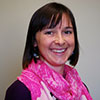
Students at a district-run preschool in Fresno match letter magnets to an alphabet chart.
Thanks to Proposition 30, getting a spot in free public preschool in Fresno just got a lot easier.
A district-wide preschool expansion, aimed at enrolling low-income 4-year-olds, was made possible when the Fresno Unified School District adopted a budget for 2012-13 that assumed Prop. 30 wouldn’t pass. When voters approved the initiative in November, Fresno was able to invest an additional $17.5 million in programs this school year.
The largest portion of the money will be used to expand preschool offerings. The district enrolled 265 new preschool students earlier this month and plans to enroll hundreds more next fall as part of a plan that aims to double the size of the current district-run program.
“There’s a nexus between early learning and graduation rates called preschool,” said Fresno Superintendent Michael Hanson.
Previously, he added, “We were just giving short shrift, frankly, to the earliest investment we could be making.”
Prop. 30, which temporarily raised the state’s sales tax and the income tax on the wealthiest Californians, will raise an average of $6 billion a year, with a little less than half going to K-12 schools and community colleges.
Still, other California school districts have not been able to add programs as Fresno has. For most districts, the urgently needed funds simply kept them from having to make more draconian cuts, said Maureen Evans, vice president of School Services of California, a leading Sacramento-based consulting firm.
“For most, it’s just, ‘thank goodness’” there isn’t another cut, Evans said. “There’s not a lot of additional spending going on.”
The Fresno district, however, will use money from Prop. 30 to reduce class sizes by hiring new teachers; increase career readiness programs in middle schools; pay for 150 teachers to earn National Board Certified credentials; and buy $1 million worth of instruments for their music program, among other expenditures. Spending on all of these initiatives has already begun.
The district will also invest $7.4 million annually in an expanded preschool program, the first time Fresno Unified has dedicated general fund money to preschool.
The expansion will help fill the gaps between the local Head Start program and other state-funded preschool programs that already operate in the city, many of them on school campuses.
About 57 percent of Fresno 4-year-olds attend public preschool now, which includes the students the district enrolled last week and those who attend Head Start. Hanson hopes the new funding will allow the district to nearly double its own program – which now serves about 1,800 students – so that 80 percent of Fresno’s 4-year-olds attend public preschool before entering kindergarten.
The district has hired 24 preschool aides to help supervise the new children, who have been merged into classrooms with current students.
If the district reaches its goal, Fresno Unified will join a few other large districts like Long Beach Unified and Los Angeles Unified that have already made a commitment to using their general fund in combination with state preschool funds to provide free public preschool for a majority of their 4-year-olds.

Students read books at a district-run preschool program in Fresno this school year.
Schools are keenly interested in the issue because a large body of research points to a correlation between attending preschool and the likelihood of graduating from high school.
Kendra Rogers of First 5 Fresno County, a county-based commission funded by a 1998 voter initiative to improve the state’s early learning programs, said it can be difficult for districts to make early learning a priority when there are so many competing interests for limited funds.
“The district needs to be applauded for this,” Rogers said. “They saw that investing in kids early on is going to be a long-term solution for some of their problems.”
Rogers said the district has also focused on improving the quality of its preschool offerings in the last few years after an early learning task force convened by the district in 2011 suggested a number of improvements. The task force, which included parents, teachers, district leaders and community members, found that district-run programs needed improvement in teacher preparation, curriculum and developing better ways to measure whether students are on track for kindergarten. With the help of her organization, the district has already begun to address some of these shortcomings, Rogers said.
“They have been very committed to quality improvement,” she said.
The additional money should allow the district to continue to improve and to serve more children, Hanson said.
First 5’s Rogers said it’s significant that a district as large as Fresno – the fourth largest in the state, which serves more than 72,000 students and has about a 17 percent dropout rate – is making an investment in early education.
“It’s a policy statement in our opinion,” Rogers said. “It’s not just the dollars attached. It’s a commitment to get kids college and career ready.”
To get more reports like this one, click here to sign up for EdSource’s no-cost daily email on latest developments in education.















Comments (1)
Comments Policy
We welcome your comments. All comments are moderated for civility, relevance and other considerations. Click here for EdSource's Comments Policy.
el 11 years ago11 years ago
This is excellent news. It’s important not only for the kids to have that time, but it’s also a great way to draw the parents into the learning community a year sooner, which is valuable for establishing a strong home-school relationship.